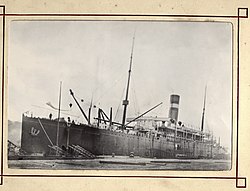Statendam (ship, 1898)
|
||||||||||||||||||||||||
|
||||||||||||||||||||||||
|
||||||||||||||||||||||||
|
||||||||||||||||||||||||
|
||||||||||||||||||||||||
The Statendam (I) was a passenger ship of the Dutch shipping company Holland-America Line that was put into service in 1898. It was used as a transatlantic liner on the North Atlantic and carried passengers , freight and mail from Rotterdam to New York . In 1910 it was sold to the British Allan Line , which it uses under the name Scotian on various routes between Great Britain, Canada and the USA. From 1918 she drove as Marglen for the Canadian Pacific Line until she was sold for demolition in 1926 and scrapped in Genoa the following year .
history
The 10,491 GRT steamship Statendam was built like many other ships of the Holland America Line at the Harland & Wolff shipyard in Belfast , Northern Ireland , and was launched on May 7, 1898. She was the first ship of the shipping company with this name (more followed in 1914, 1929, 1957 and 1993) and the first ship in the HAL fleet with a tonnage of over 10,000 GRT. The first Statendam was a 157.05 meter long and 18.19 meter wide passenger ship with a chimney, two masts and two propellers . The ship could carry 200 passengers in the first, 175 in the second and 2000 in the third class.
On August 24, 1898, the Statendam left Rotterdam on her maiden voyage to New York . She stayed on this route until January 1910. On March 23, 1911, the ship was sold to the British Allan Line , which renamed her Scotian and provided passenger accommodation for 550 second and 1150 third class travelers. The tonnage was reduced to 10,332 GRT. It initially commuted between Glasgow , Halifax and Portland , until it was put on the Canada route (Glasgow - Quebec - Montreal ) in May 1911 . In January 1914 she was chartered to the Canadian Pacific Line for a single crossing from Liverpool to Saint John .
On 21 August 1914 the put Scotian in London for their last journey from peacetime. On the return trip to Great Britain, she was used as a troop transport for the Canadian Expeditionary Force . Between November 1914 and March 1915 she served as a barge for German prisoners of war in the coastal town of Ryde on the Isle of Wight . On September 13, 1916, while she was anchored at Princes Dock in Glasgow, the Scotian was hit in a collision at the stern by the troop carrier HMS Mantua (ex- P&O ) .
When the Canadian Pacific Line bought the Allen Line in 1917 and took over their ships, the Scotian also passed to the new owners in July 1917, for whom she was in service from September 1918. From September 12, 1919, the Scotian served the route from Antwerp via Southampton to Québec and Montreal with a capacity for 304 passengers in cabin class and 542 in third class . From May 1920, London was the starting point of the crossings. In 1920 and 1921 the ship made four troop trips to Bombay (India) in the service of the British government.
On November 16, 1922, the name was changed from Scotian to Marglen . At this point, however, the steamer was already approaching the end of its service life. On May 15, 1923, the Marglen left for Canada for the last time in London. In the following three years 15 crossings to Bombay followed and on December 30, 1926, the 28-year-old ship was finally sold to Ditta L. Pittaluga in Genoa for scrapping . On January 10, 1927 it left Southampton for Genoa, where it was scrapped that same year.
